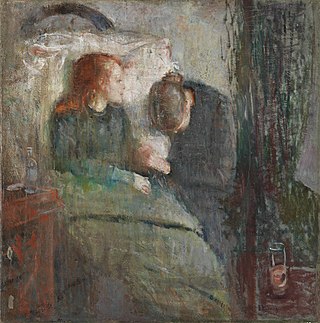
Edvard Munch was a Norwegian painter. His 1893 work, The Scream, has become one of Western art's most acclaimed images.

Munch Museum, marketed as Munch since 2020, is an art museum in Bjørvika, Oslo, Norway dedicated to the life and works of the Norwegian artist Edvard Munch.

The Scream is a composition created by Norwegian artist Edvard Munch in 1893. The Norwegian name of the piece is Skrik (Scream), and the German title under which it was first exhibited is Der Schrei der Natur. The agonized face in the painting has become one of the most iconic images of art, seen as symbolizing the anxiety of the human condition. Munch's work, including The Scream, had a formative influence on the Expressionist movement.

Petter Halfdan Rudolf Fredrik Olsen is a Norwegian businessman, billionaire and member of the Olsen shipping family, who own Fred. Olsen & Co. He is the younger brother of the current leader of the company, Fredrik Olsen. Petter Olsen formerly owned one of the four versions of Edvard Munch's The Scream (1895), one of the world's most iconic works of art. The older brother, Fredrik Olsen, had been involved in a legal process against his younger brother concerning The Scream and other Munch works that had been collected by their father, Thomas Fredrik Olsen. According to the will of their mother, Henriette, the collection was to be left to the younger son. Fredrik Olsen disputed the will but lost the case in the Oslo District Court in 2001. Petter Olsen's version of The Scream was sold on 2 May 2012, selling for an auction record price of US$119.9 million, including fees and commission. Petter Olsen sold the painting to raise funds to build a museum in Hvitsten, Norway, where Munch once owned property and near where Olsen has an estate, to house the rest of his father's collection.

The Sick Child is the title given to a group of six paintings and a number of lithographs, drypoints and etchings completed by the Norwegian artist Edvard Munch between 1885 and 1926. All record a moment before the death of his older sister Johanne Sophie (1862–1877) from tuberculosis at 15. Munch returned to this deeply traumatic event repeatedly in his art over a period of more than 40 years. In the works, Sophie is typically shown on her deathbed accompanied by a dark-haired, grieving woman assumed to be her aunt Karen; the studies often show her in a cropped head shot. In all the painted versions Sophie is sitting in a chair, obviously suffering from pain, propped by a large white pillow, looking towards an ominous curtain likely intended as a symbol of death. She is shown with a haunted expression, clutching hands with a grief-stricken older woman who seems to want to comfort her but whose head is bowed as if she cannot bear to look the younger girl in the eye.

Underdrawing is a preparatory drawing done on a painting ground before paint is applied, for example, an imprimatura or an underpainting. Underdrawing was used extensively by 15th century painters like Jan van Eyck and Rogier van der Weyden. These artists "underdrew" with a brush, using hatching strokes for shading, using water-based black paint, before underpainting and overpainting with oils. Cennino D'Andrea Cennini describes a different type of underdrawing, made with graded tones rather than hatching, for egg tempera.

The National Gallery is a gallery in Oslo, Norway. Since 2003 it is administratively a part of the National Museum of Art, Architecture and Design.

Melancholy is a painting by the Norwegian artist Edvard Munch. Munch painted multiple variant versions of the expressionist work in oil on canvas during the period 1891–1893. The painting depicts a man with his head resting in his hand in a pensive mood at the edge of a shoreline.

Anxiety is an oil-on-canvas painting created by the expressionist artist Edvard Munch in 1894. It is now in the Munch Museum in Oslo, Norway. Many art critics feel that Anxiety is closely related to Munch's more famous piece, The Scream (1893). The faces show despair and the dark colors show a depressed state. Many critics also believe it's meant to show the emotions of heartbreak and sorrow.

The Kiss is an oil painting on canvas completed by the Norwegian symbolist artist Edvard Munch in 1897. Part of his Frieze of Life, which depicts the stages of a relationship between men and women, The Kiss is a realization of a motif with which he had experimented since 1888/89: a couple kissing, their faces fusing as one in a symbolic representation of their unity. Exhibited as early as 1903, this work is held at the Munch Museum in Oslo.

Love and Pain is an 1895 painting by Edvard Munch; it has also been called Vampire, though not by Munch. The painting depicts a man and woman embracing, with the woman kissing the man on his neck. Munch painted six different versions of the same subject between 1893 and 1895. Three versions are in the collection of the Munch Museum in Oslo, one is held by the Gothenburg Museum of Art, one is owned by a private collector, and the final work is unaccounted for. Munch painted several additional versions and derivatives of the work later in his career.

Model by the Wicker Chair is a 1919–1921 painting by the Norwegian artist Edvard Munch that is in the collection of the Munch Museum in Oslo.

Inger on the Beach is a painting by the Norwegian artist Edvard Munch. It was created in the summer of 1889, at Åsgårdstrand and is a portrait of Munch's youngest sister Inger.

Jappe Jacob Nilssen was a Norwegian writer and art historian.
Arne Kristian Eggum is a Norwegian art historian who mainly focused his scientific work on Edvard Munch.

Ashes is an oil on canvas painting by the Norwegian symbolist painter Edvard Munch. Painted in 1894–95 it is now in the collection of the National Gallery of Norway in Oslo.

Self-Portrait with Cigarette is an 1895 painting by the Norwegian artist Edvard Munch. Munch's use of the cigarette and physical decay as a rejection of societal values aroused controversy following the self-portrait's 1895 exhibition. As of 2021, the work is held by the National Gallery in Oslo.

Death and the Child is a composition created by Edvard Munch in 1889. Since 1918 it is located in the Kunsthalle Bremen. It depicts a little girl at her mother’s deathbed who is looking at the viewer in a fearful manner. A second, thus far unknown painting of the artist was discovered underneath the canvas in 2005. A new version of that motif, which refers to Munch’s family and the early death of his mother was created between 1897 and 1899 and is now hanging in the Munch Museum in Oslo. An etching was made in 1901 with this motif.

Inheritance is an oil painting on canvas created by the Norwegian painter Edvard Munch (1863–1944). It depicts a mother with syphilis holding her baby, who is affected by congenital syphilis. Munch completed the work after visiting the Hôpital Saint-Louis in Paris, where he saw a woman crying for her child with the disease.





















